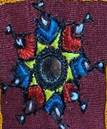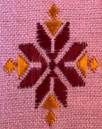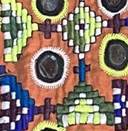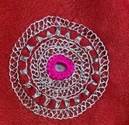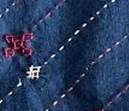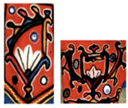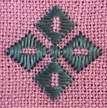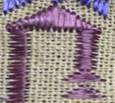ShodhKosh: Journal of Visual and Performing ArtsISSN (Online): 2582-7472
|
|
INDIGENOUS HERITAGE OF TRADITIONAL EMBROIDERY PRACTICED BY MEGHWAL COMMUNITY
Dr. Madhu Sharan 1![]()
![]() ,
Mitali Shah 2
,
Mitali Shah 2![]()
![]() ,
Dolly Agrawal 3
,
Dolly Agrawal 3![]()
![]()
1 Professor,
Department of Clothing and Textiles, Faculty of Family and Community Sciences,
The Maharaja Sayajirao University of Baroda, India
2 Assistant
Professor, Textile and Apparel Design, Institute of Fashion Technology, Faculty
of Family and Community Sciences, The Maharaja Sayajirao University of Baroda,
India
3 Researcher, Department of Clothing
and Textiles, Faculty of Family and Community Sciences, The Maharaja Sayajirao
University of Baroda, India
|
|
ABSTRACT |
||
|
Artisanal
skills in India are recognized as beautiful reflection in hand made arts and
crafts. The present study was an attempt to document the history, origin,
motifs, tools, and equipment’s used for embroidery practiced by Meghwal
Community residing in Gujarat and Rajasthan. This type of embroidery is rare
in its being; hence the main analysis of the study was to make people aware
about Meghwal embroidery from the embroideries practiced by different
communities. At present embroidery is mainly being practiced in two districts
Bikaner (Rajasthan) and Kutch (Gujarat). A total sample comprised of 110
artisans of which 55 were from each district along with two NGO were selected
one from each district. The sample selection criteria was
determined by keep in view their involvement with
Meghwal embroidery. According to the artisan, there was no significant
difference in the embroidery practiced in Rajasthan and Kutch. The details of
traditional style embroidery, as well as other information like existing
motifs colour combinations, stitches, threads, and other raw materials was
studied. According to the artisans and review of literature, Meghwal
embroidery can be identified by its motifs and method of execution and motif
development. The stitches are the same, but the identity of the embroidery
practiced by the community is reflected in the methods of motif’s
development, the fabric and colour combination was changed according to the
market demand. |
|||
|
Received 06 July 2023 Accepted 28 September 2023 Published 02 October 2023 Corresponding Author Dolly
Agrawal, agrawaldolly99@gmail.com DOI 10.29121/shodhkosh.v4.i2.2023.591 Funding: This research
received no specific grant from any funding agency in the public, commercial,
or not-for-profit sectors. Copyright: © 2023 The
Author(s). This work is licensed under a Creative Commons
Attribution 4.0 International License. With the
license CC-BY, authors retain the copyright, allowing anyone to download,
reuse, re-print, modify, distribute, and/or copy their contribution. The work
must be properly attributed to its author.
|
|||
|
Keywords: Traditional Art, Craft Documentation, Ethnographic Studies |
|||
1. INTRODUCTION
To understand any art and craft of any community it is necessary to know the background of artisans and craftsperson. It is also important to understand the geography, migration details and influences of other crafts practiced around the area. Among the arts and crafts of Rajasthan and Gujarat, one of them is an art practiced by the Meghwal community. The origin of the Meghwal community and their historical background has been much debated among the Meghwal clusters residing in different geographical settlements. Different geographical and cultural groups of Meghwals, who have came to known to as “Meghwar”, “Meghwal”, “Megh” or “Meghval” usually trace their origin to ancient Indian history. The term Meghwal also called as Meghwars is derived from the Sanskrit words `Megh` that means cloud or rain and `War` means those who pray. There are two perspectives about the origin of the community which has come out from the data. One, there were considered as the decedents of the Megh rishi who worshipped rain and the other claims that they were born from the feet of Brahma indication the lower level in the caste system followed. Meghwal community believes that all God are equal and they bow down to every Gods. They worship people who have done things for the community. Megh Rishi and Rohidas have done things for the community. It was traced back, that during the 17th century Meghwal Community was found scattered in the regions from Rajasthan to Sindh. As informed by the artisans and literature reviewed it was found that till 1971, Meghwal community mostly resided in Rajasthan in India and Sindh in Pakistan. After the Indo-Pak war in 1971, Meghwal community was spotted in Kutch. This population has migrated from Sindh as well as Rajasthan, so majority of the Meghwal community were found in Rajasthan and Gujarat in India. Another review states that the birth of Meghwal community originally was in the Sindh and after that community started migrating to Gujarat, Rajasthan, Madhya Pradesh, Kashmir, Mumbai, and Pakistan. Anonymous (1979)
Embroidery is an important part of their visual culture because it is used on wedding products and dowry items. Mirror embroidery is distinguished by its fine workmanship, dense coverage, vibrant colours, and elaborate motifs and finished edges. Meghwal embroidery is classified into two types: Pakko and Kachho.
This embroidery was initially done by the females of the house during their leisure time. It was done on the traditional garment “Kanjari” which was worn by the women and girls of the community. The embroidery done was very intricate and was embellished by the finally set “mirrors”. Then they started doing embroidery on dowry articles also and it became part of the dowry. With dowry this embroidery also moved to the places where the girls of the community got married. They were reusing the embroidery pieces after the dress was worn out on some of the household articles. (ref. 6,7) Crill et al. (1997)
Figure 1

|
Figure 1 Meghwal Woman |
2. OBJECTIVES
· To study the origin and development of Meghwal embroidery.
· To identify the main characteristic features of Meghwal embroidery.
· To document the embroidery process, tools and equipment used for the embroidery.
· To study the present status of Meghwal embroidery.
3. METHODOLOGY
The present research was descriptive research which was divided into two Phase-I Data collection and Phase-11 Analysis of data. A multi-methodological approach was adopted, and data was collected through the snowball technique. For the study, two districts were taken Kutch (Gujarat) and Bikaner (Rajasthan). 110 artisans were selected from which 55 were from Kutch and 55 were from Bikaner and two NGOs were selected one from Kutch and one from Bikaner. The selection of the sample was done according to the artisans and NGOs involved in practicing Meghwal embroidery. Data collection was done by both primary sources and secondary sources using various methods like Field visits, personal interviews, photography, and recordings. Interview schedule was prepared according to the objectives of the study to collect the primary data from the artisans and NGOs involved. Keeping in mind both open and close-ended questions were included in the schedule. The interview was carried out in three languages English, Hindi, and Gujarati as per the craftsperson's convenience. The analysis of data was done through graphs, and tables and was supported by photos and a description was given. Dholakia (2012)
4. RESULTS
Demographic
details of the respondents
From the review, it was found that majority of the Meghwal community is
settled in Bikaner in Rajasthan and Kutch in Gujarat, so the respondents were
selected from both states. A total of 110
respondents (artisans) were included in the study of which 55 respondents were
from each state. Demographic details of the artisans is
also one of the factors in understanding the status of the craft. Following
table summarizes the components of demographic details of the respondent.
Table 1
|
Table 1 Demographic Details of the Respondents of Bikaner and Kutch n=110 |
|||||
|
Components |
Bikaner |
Kutch |
|||
|
Number |
Frequency
(%) |
Number |
Frequency
(%) |
||
|
Age |
15-25 |
2 |
4 |
8 |
14 |
|
26-35 |
9 |
16 |
7 |
13 |
|
|
36-45 |
30 |
55 |
34 |
62 |
|
|
46-55 |
10 |
18 |
2 |
4 |
|
|
56-65 |
4 |
7 |
4 |
7 |
|
|
Gender |
Female |
48 |
87 |
42 |
76 |
|
Male |
7 |
13 |
13 |
24 |
|
|
Residential
Status |
Local |
43 |
78 |
30 |
60 |
|
Migrated |
12 |
22 |
20 |
40 |
|
|
Monthly
Income |
Less
than Rs. 10,000 |
0 |
0 |
0 |
|
|
Rs. 10,000-15,000 |
41 |
75 |
25 |
45 |
|
|
Rs.
16,000-20,000 |
9 |
16 |
28 |
51 |
|
|
More than Rs. 20,000 |
5 |
9 |
2 |
4 |
|
|
Occupation |
None |
46 |
84 |
43 |
78 |
|
Other than embroidery |
Business |
0 |
0 |
7 |
13 |
|
Service |
0 |
0 |
0 |
0 |
|
|
Student |
0 |
0 |
5 |
9 |
|
|
Any
other |
9 |
16 |
0 |
0 |
|
|
Education |
None |
37 |
67 |
40 |
73 |
|
Primary |
12 |
22 |
11 |
20 |
|
|
Secondary |
6 |
11 |
3 |
5 |
|
|
Graduation |
0 |
0 |
1 |
2 |
|
|
Any other |
0 |
0 |
0 |
0 |
|
Graph 1

|
Graph 1 The Age Structure of Artisans |
Graph 1 gives the age structure of all who participated in the study. It
includes the age of the artisans of Kutch and Bikaner. The majority of the respondents were from the age group of 36-45 years which
was 55 percent from Bikaner and 62 percent from Kutch. This indicates that
middle age population of the artisans are more willing to share the knowledge
and are looking forward for discussion about their traditional embroidery.
Edwards
(2011)
Graph 2

|
Graph 2 Genders of Artisans |
Graph 2 Includes the gender details of all who participated in the study. It
includes the gender of the artisans of Kutch and Bikaner. The majority of the respondents were females which was from Kutch it was
76 percent and Bikaner it was 87 percent. Though traditionally the embroidery
was done by the women folk only, but over a period of time
men have also ventured into this profession. The high ratio of females involved with this art is also reflected in the group of
the respondents selected for the study.
Graph 3

|
Graph 3 Residential Status of Artisans |
Graph 3 Includes the residential status
details of all who participated in the study. According to the data the 60
percent artisans of Kutch are local and 40 percent of
the artisan are migrated either from Rajasthan or Pakistan. Whereas in Bikaner
78 percent of the artisans are local and 22 have migrated from Pakistan to
Bikaner.
Graph 4

|
Graph 4 Monthly Income of the Artisans |
From the graph above it was
observed that from Kutch.45 percent respondent's
monthly income was between Rs.10,000-15,000, 51 percent between
Rs.16,000-20,000 and only 4 percent of the respondents were having income more
than Rs 20,00 whereas 75 percent respondents income was between
Rs.10,000-15,000, 15 percent was between Rs.16,000-20,000 and only 9 percent of
the respondents were having income more than Rs20,000 which was from Bikaner.
From both the districts none of the respondents
has income less than 10,000. Frater
(2000)
The majority
of the artisans were earning between
Rs. 10,000-20,000 per month. They were not satisfied with their earnings and
wanted to have increase in income. In Bikaner there was not much disparity in
income among the artisans. The majority of them were
earning between Rs. 10,000-15,000 per month.
But in Kutch, it was observed that a
good number of artisans were earning more than Rs, 15,000 per month. This
indicates that embroidery is more in demand from the artisans of Kutch as
compared to the artisans who have stayed back in Rajasthan.
Graph 5
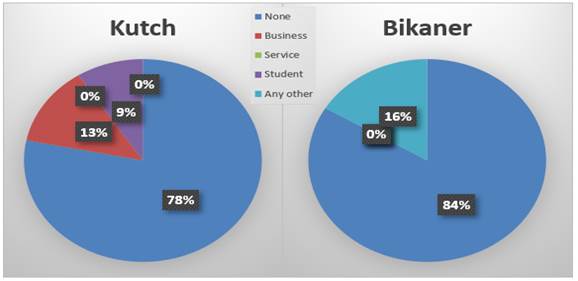
|
Graph 5 Occupation of Artisans |
From the graph above, it was
observed that majority of the artisans have sticked to the embroidery as their
profession in both the states. From Kutch, the young people have continued
their study along with this profession and some of the artists have ventured
into business of selling their own products. While the
majority of artisans in Bikaner have sticked to the embroidery as their
sole profession, few of them are engaged in other work like helping in farming
for their income.
Graph 6
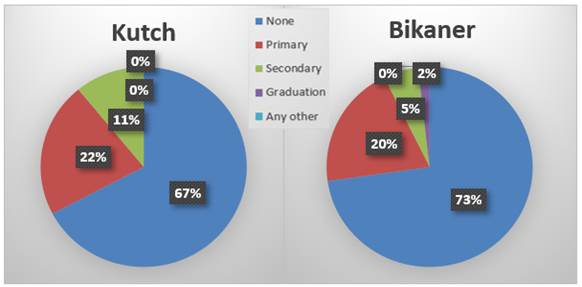
|
Graph 6 Education Details of Artisans |
From Graph 6, it was seen that majority of the respondent from Kutch and Bikaner are
not educated. But now they feel formal education is necessary along with the
skills to survive and flourish in this present scenario and their children need
to be educated. They were willing to send
their children for higher education. Some of the artisans had primary level
education and few up to secondary level. In Kutch, one of the artisans was
a graduate and a few
others with education up to primary or
secondary level. There was a need to develop
a system of formal education which supports the
artisan’s family to be educated. Formal education is an integral element for
the development of any individual leading to developed society including
cultural development. Ibrahim
(2020)
Table 2
|
Table 2 Knowledge of Different Languages (Multiple Answer Question) |
||
|
Language |
Kutch |
Rajasthan |
|
Frequency |
Frequency |
|
|
Gujrati |
13 |
0 |
|
Hindi |
10 |
42 |
|
English |
5 |
0 |
|
Any
other |
72 |
58 |
From the data collected about
the knowledge of different languages among the artisans, it was observed that
from the artisans of Kutch all the respondents knew "Kacchi",
"Marvadi" and "Sindhi”, and only 10 of them knew Gujarati, 08 knew Hindi and
because of some international customers 4 knew English also. From Bikaner all
the respondents knew "Marvadi" and none of
them were familiar with Gujarati and English, 40 of 55 participants knew Hindi.
This indicated that they were interacting with local people only. For any
culture or business to flourish it is very much necessary to have communication
from the outside world for which language is
the most important aspect. In Kutch, extended communication through language
was observed which was an indicator of
progress. Pandya
& Dholakia (2013)
Table 3
|
Table 3 Use of Social Media by the Respondents (Multiple Choice) |
||
|
Social media |
Kutch |
Rajasthan |
|
Frequency |
Frequency |
|
|
WhatsApp |
27 |
18 |
|
Facebook |
6 |
4 |
|
Instagram |
14 |
7 |
|
Any
other |
5 |
6 |
|
None |
48 |
65 |
Table 3 includes the details regarding are respondents familiarity with any social media. From Kutch 35
of the respondents didn’t knew how to use any of the social media. From
remaining 20, only 4 of them was aware of Facebook, 10 knew Instagram and 4 of
them were aware about other apps like you tube, and 20 of them used WhatsApp.
From Bikaner 36 of the respondents didn’t knew how to use any of the social
media and only 2 knew about Facebook, 4 knew Instagram and 3 of them were aware
about other apps like you tube, and 10 of them used WhatsApp. Awareness of
social media was observed amongst the artisans though with less number. For the
development of any art, its progression and popularization, nowadays social
media is playing a very important role and has proved to be an effective tool
also. From the above data it was observed that there was need to run programme to create awareness about the
social media and training of the artisans.
History of Meghwal
Embroidery
Over a period of time the number of artisans reduced but those who were still engaged in this art made it a profession and started selling the embroidered pieces and making it on demand. The latter influenced the pattern and techniques of Meghwal embroidery. Majority of the respondents were unaware about the origin and history of the embroidery practiced by them. From childhood they have learned this art step by step using part of this on different base materials. It was observed that after 1947, this embroidery came into the market and even men were introduced in this business. Over a period of time, the embroidery done by women got placed on the leather items, and woven items done by men of the community. Many products like purse, bag, chappal, mobile cover, cushion covers were seen in the market, which have evolved to better quality products. Patel (1987)
Figure 2

|
Figure 2 Mobile Cover |
Figure 3

|
Figure 3 Purse |
Figure 4
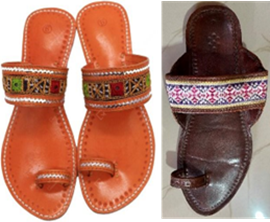
|
Figure 4 Chappal |
The Meghwal embroidery was done by manipulating the running stitch in different ways combined with the stem stitch, chain stitch and back stitch. This whole work was given a great emphasis with the use of mirror different sized big, medium, small, and round in shape. Embroidery was done with great skill to form the design. The base material used for embroidery was cotton generally in dark shades. They used threads of different colours, beautiful designs and mirrors and other reflecting options. The material was in great demand at the time of festivals because of the colours. Mirrors were an essential component of Meghwal embroidery. And no use of embroidery was there on costumes. The traditional garments of the women were “Kanjari”, “dupatta” and “Ghagra” which were made by themselves. This was supplemented with the jewellery which was made of silver, gold and precious stones and features unique designs and patterns.
The characteristic features of the Meghwal embroidery were its geometric patterns (which were never traced but embroidered beautifully), use of multicolour threads and mirrors. According to the artisans and reviews, Meghwal embroidery can be identified by its motifs and method of execution and motif development. Every community embroidery has its own style, method, and motifs. The stitches are the same, but the identity of the embroidery practiced by the community is reflected in the motifs character and development, i.e., the way the stitches are used in the development of the motif. Sharan et al. (2023)
The number colours used in Meghwal embroidery to develop a motif were either two colours or three, not more than three colours were used. In Meghwal embroidery, the use of pompoms made of thread with beads in the center was observed.
Details of the
embroidery
During the field visit, it was observed that there was not much difference in the embroidery pieces done by the artisans of Gujarat and Rajasthan.
Stitches
According to the analysis of data from the artisans, stitches practiced were
1) Pakko: The motifs were primarily floral and generally arranged in symmetrical patterns and generally was done with Outline - Double satin stitch/Chain stitch, Filling- Square chain stitch, Mirror- Button hole/ square chain stitch, Romanian stitch.
Figure 5
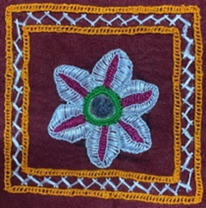
|
Figure 5 Pakko |
2) Naren: It was a triangle-shaped unit which resembled the shape of an eyebrow as explained by the artisans. The single unit was multiplied to get the required shape and motifs. These motifs were made with the geometrical arrangement. For outline- Double satin stitch/Chain stitch, for filling- square chain stitch a and for mirror- Buttonhole stitch were used.
Figure
6
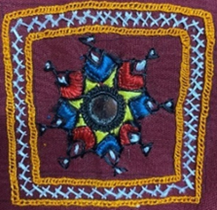
|
Figure 6 Naren |
3) Kambira: It was a square formed with the zigzag lines. This embroidery was done without tracing the design. It was embroidered in a concentric manner. The stitches used to create this embroidery was single and double running stitch and satin stitch.
Figure 7
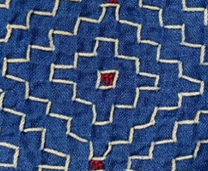
|
Figure 7 Kambira |
4) Mukka: It was in the circular form. As said by the artisans it was practiced without any tracing of the design. Stitch was couching stitch and motif was known as Gheni.it was done with silver and golden colour. It was the depiction of a coin.
Figure 8
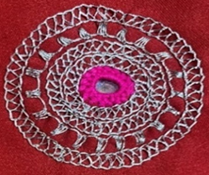
|
Figure 8 Mukko |
5) Khareek: It was a geometric style and was done by counting the threads. In this style, the artisan works out the structure of geometric step patterns with an outline of black squares without marking. For Outline-Back stitch and for Filling- single satin stitches were used.
Figure 9
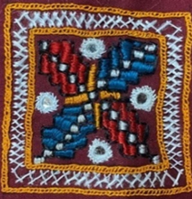
|
Figure 9 Khareek |
6) Suff: It was done by counting the warp and weft yarns of the cloth. Each artisan imagined their designs and then counted it out in reverse. The embroidery was a geometric pattern developed by arrangements of triangles in different orders and sizes to build up a motif. Stitch used for motif development: single satin stitch for filling.
Figure 10
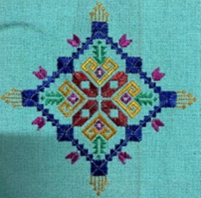
|
Figure 10 Suff |
|
Motifs used in different stitches |
|||||
|
Pakko |
Naren |
Suff |
Khambira |
Khareek |
Mukka |
|
Badam Tak |
Bonta |
|
Kham biro |
|
Gheni |
|
Rano
bandh |
|
Sangi |
Khudi taco |
|
|
|
Mor |
|
Golada |
|
|
|
|
Tak
chopad |
|
Bhakhiya |
|
|
|
|
Char butti no gul |
|
Lat |
|
|
|
Raw materials
The embroidery is completely done by hand. Previously, the Handspun and handwoven cotton fabric was made by the artisans themselves, but it is now sourced for the market. Green, blue, red, and yellow were previously used colour combinations, according to the artisans. The colour combination was done according to the base fabric and in a systematic manner. They are, however, being used as more colours become available on the market. The art was transferred from one generation to other. No formal training was taken by the artisans for developing a beautiful art with beautiful designs and arrangement of motifs. The principles of design such as rhythm, emphasis, proportion, and balance were followed by the artisans while planning the layout, motifs arrangement and colour combination and size of the motifs varied as per the article to be embroidered. Thontya (2022)
5. DISCUSSION
According to the analysis of data, in this embroidery generally six stitches Pakko, Khareek, Kambira, Suff, Naren, Mukka were used. Base fabric was cotton and now it has been changed to silk, Mashru, linen. Cotton embroidery thread and silk floss was used for embroidery. Geometrical motifs with different placements were used. Earlier embroidery was done without tracing the design but nowadays they are tracing the design and doing the embroidery. The embroidered products include traditional apparels and utility items like bags, slippers, pillow covers, chappals. According to the artisans and reviews, Meghwal embroidery can be identified by its motifs and method of execution. Every embroidery community has its own style, method, and motifs. The stitches are the same, but the identity of the embroidery practiced by the community is reflected in the motifs' character and development, i.e., the way the stitches are used in the development of the motif.
6. CONCLUSION
The primary purpose of the study was to document the traditional embroidery of Meghwal Community. For male the main occupation was farming, wood carving and leather work. For women along with the household work embroidery and weaving were the main occupation. The study would also give an insight into the style of traditional embroidery art and provide information pertaining to traditional as well as existing motifs, colour combination, stitches, threads, and other raw materials.
7. Acknowledgement
Authors would like to thank all the artisans. Authors are especially grateful to Karan Marvada, Bhoja Kesa Marvada, Pababen Marvada, Arjun Marvada, Dayi ben Marvada, Gulab Bhannani, Geetaben Bhannani, Phulwanti Gadhveer and all the other artisans for their corporation and sharing information with me. Sincere thanks to Mr. Rohitash Kantiya, Mr. Sunil Lahri (Director) and Mr. Hemaram of Urmul Seemant Samiti, Bikaner. Mr. Mukesh Bhannani from Kala Raksha, Kutch. Qasab NGO, Kutch for supporting and sharing information with me.
8. Authors contribution
This is the original work of master’s dissertation. Interview schedule was prepared which was verified. Personal field visit was done. It is approved by the Ethical committee and Faculty research association committee of Faculty of Family and Community Sciences and The Maharaja Sayajirao University of Baroda.
9. Conflict of interests
None.
REFERENCES
Anonymous (1979). Handicrafts of Kutch, Ashapuri Printery, Bhuj.
Crill, R., Askari, N., & Holberton, H. (1997). Colours of the Indus : Costume and Textiles of Pakistan. London : 15-63.
Dholakia, K. L. (2012). Prevailing Status of Kutch Embroideries and Artisans : Scope of its Sustainability and Promotion (Published Ph.D. Thesis) Department of Clothing and Textiles, Faculty of Family and Community Sciences, The Maharaja Sayajirao University of Baroda, Vadodara.
Edwards, E. (2011). Textiles and Dress of Gujarat. Ahmedabad : V & A Publication in Association with Mapin Publication.
Frater, J. (2000). Embroidery : A Women's History of Kutch, In Christopher, The Arts of Kutch, Marg Publication. 63(2), 23-96.
Ibrahim, F. (2020). Settlers, Saints and Sovereigns: An Ethnography of State Formation in Western India. India: Taylor & Francis. https://doi.org/10.4324/9780367817763
Pandya, A., & Dholakia, K. L. (2013). Historical Overview of Kutch Embroideries. Indian Journal of Traditional Knowledge, 12(3), 524-529.
Patel, N. (1987). A Study of Embroideries of Kutch and Kathiawar. (Unpublished Master's Dissertation) Department of Clothing and Textiles, Faculty of Family and Community Sciences, The Maharaja Sayajirao University of Baroda, Vadodara.
Sharan. M., Shah. M., Chauhan, A. (2023). A Study on Progression of Sanganeri Block Print, Journal of Textile Association. 320-324. https://doi.org/10.56716/4/1447
Thontya, M. D. (2022). Meghwar : History and Cultural, Endowment Fund Trust, Karachi, Pakistan.
|
|
 This work is licensed under a: Creative Commons Attribution 4.0 International License
This work is licensed under a: Creative Commons Attribution 4.0 International License
© ShodhKosh 2023. All Rights Reserved.



